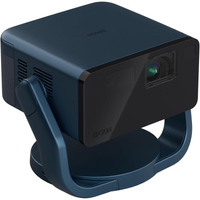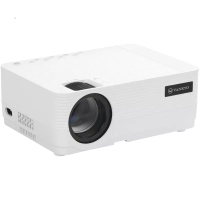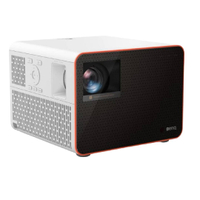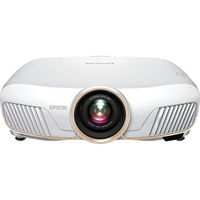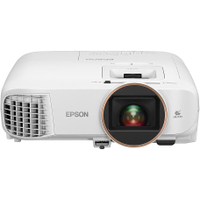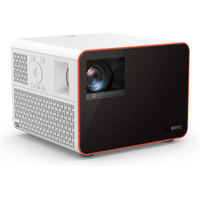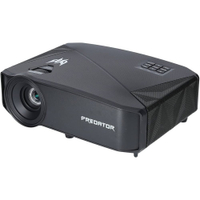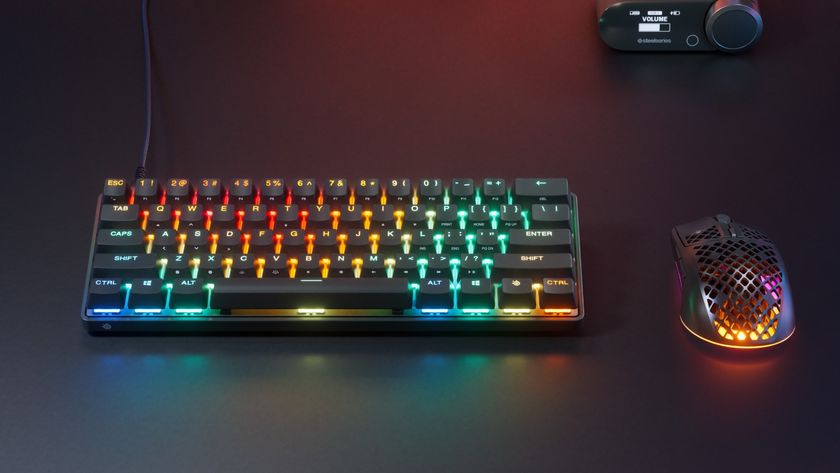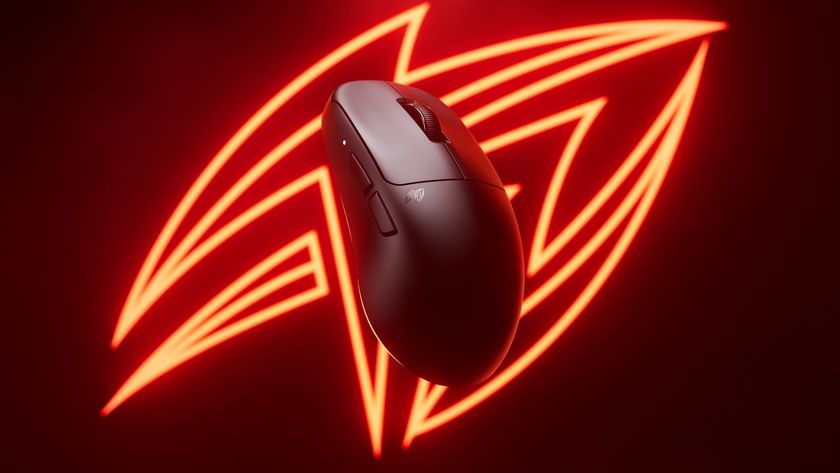The best projector for gaming in 2025
These are the best home projectors for gaming and entertainment
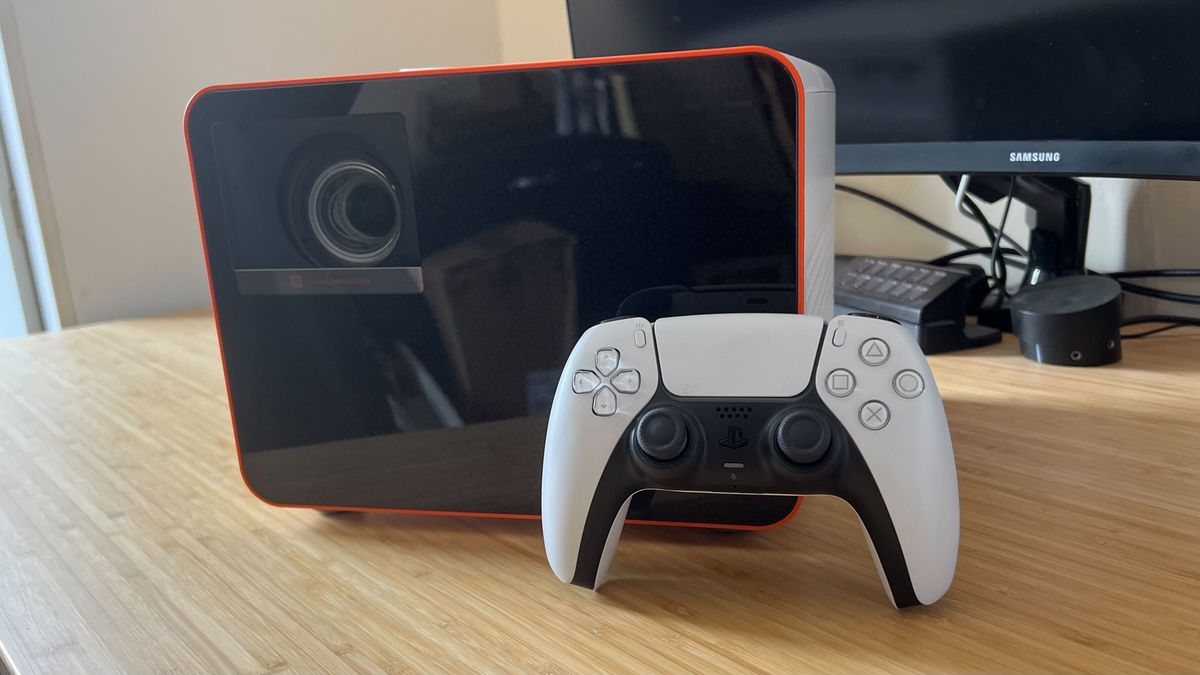
The best gaming projectors can elevate pretty much any console or PC setup. Taking that action to the even-bigger screen makes your games feel like a whole new experience. Unlike TVs, these projectors can sit quietly in your home waiting for their moment to shine - you try decorating around a 90-inch TV and you'll see why they're rapidly gaining popularity.
That's not even the best part. Not only has the tech inside these devices caught up to modern gaming standards, but they're also considerably cheaper than they once were. This is still an investment if you want super crisp 4K picture and smooth refresh rates but they're within the realm of a high-end TV's cost these days.
You'll need to pick out the best projector specs for your room size, but you’ll also want to think about the surface you’re projecting onto and the times of day you'll be using it. The key things to keep an eye out are lumens (essentially brightness, the higher this is the better the picture will be when the lights are on) and throw distance (how far away from the surface you’re projecting on the unit needs to be to give a big enough picture).
Right now, the best projector for gaming is the BenQ X3100i, a 4K thrower with enough juice for 240Hz 1080p console gameplay and a fantastic picture quality. However, there are plenty other with slightly different specs that might suit you better just below.
The Quick List
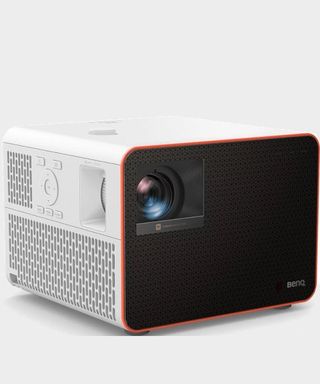
The latest BenQ flagship boosts brightness and contrast while still offering the low-latency experience we all know and love.
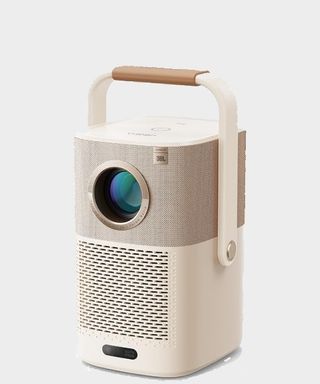
The Yaber T2 (or T2 Plus if you buy the streaming stick as well) is a fantastic 1080p projector that punches well above its price tag. Regularly on sale, this is a budget, and aesthetics, friendly thrower.
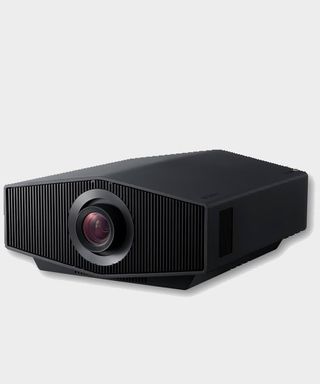
This is a high-end beast for those looking to create a luxury home cinema and still have their consoles keep up.
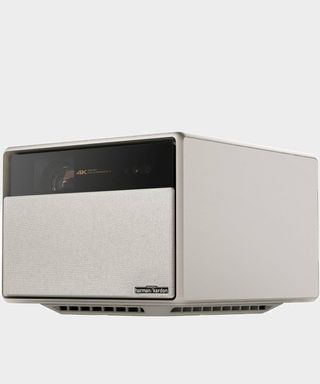
If you need to fill a larger space with color and sound, the XGIMI Horizon Ultra is a fantastic option with excellent HDR and a super bright picture.
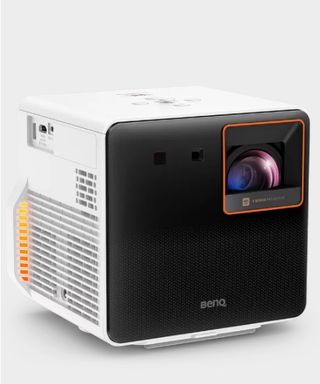
Not only is the BenQ X300G a fantastic 4K projector in its own right, it's the best in the business for more versatile short throws.

One of my first jobs was in the projection room of a movie theatre as a teenager, and since then I've loved big-screen entertainment. Pair that with a lifelong obsession with gaming and you've got yourself an expensive hobby. I went through loads of cheap projectors before starting my quest to find the best model on the market. In my three years at 12DOVE I've been testing projectors with a laser focus on speed, brightness, clarity, and - most importantly - value for money.
Recent updates
March 31 - The Acer Predator GD711 was a heavyweight in the world of the best gaming projectors, but it's fallen from grace. The VRR-enabled thrower is now incredibly difficult to find in new condition on the shelves, and prices are starting to climb. That means it's been removed from this list and added to the 'Also Tested' section in today's update.
The best projector for gaming overall






Specifications
Reasons to buy
Reasons to avoid
There's a new kid in town, and the BenQ X3100i has taken over from the previous generation BenQ X3000i as our favorite projector for gaming overall. This is an iterative update in terms of core specs, but a boost to brightness and contrast, and a few fancy new features set it apart from the crowd. While PC players might lament the lack of Dolby Vision HDR, there's still plenty for all platforms to enjoy here.
✅ You want 4K without the price tag: A native 4K projector costs twice this MSRP, and considering the BenQ uses pixel shifting tech so well you're still getting fantastic image quality.
✅ You want easy picture adjustment: While not automatic, the vertical lens shift dial is brand new here and means you can move your whole picture up or down to fit your space. Plus, handy focus and zoom scrolls on the side keep things snappy as well.
✅ You play more competitive games: With super-fast 1080p latencies, the BenQ X3100i moves pretty slick on the battlefield.
❌ You have a smaller space: The form factor means this isn't a projector designed to squeeze into a tighter space.
❌ You need Dolby Vision for PC: If your handheld or PC runs using Dolby Vision HDR you might want to consider a model that supports it.
Design: The latest model slots right in with the rest of BenQ's lineup. Its boxy white aesthetic is softened by rounded corners and a fun orange trim around the black front, while the entire unit remains relatively compact for a projector. This isn't a tuck-and-forget device, it's still got a considerable footprint (if you need a cozier setup, check out the X300G below), but it's still far from the chunkier models on the market. You'll have an easier time keeping this model on a shelf than you will some wider but shorter alternatives. All controls are housed on either the top or left-hand side, with each button and dial feeling solid and satisfying during our testing.
Features: This is a projector built for gaming from the ground up, which means you've got access to a number of genre-specific game modes as well as your standard HDR / SDR picture options for streaming. At its fastest, the BenQ X3100i can reach speeds of 4.2ms (1080p / 240Hz), while 4K picture will fly at you at 16.7ms (60Hz). That's impressive considering the vast majority of projectors could only dream of these latencies, and makes for a particularly smooth experience if you tend to play competitive games. On top of that the X3100i has improved upon the X3000i's brightness and contrast, added a vertical lens shift option, and brings a unique picture settings software to market as well.
Performance: Testing across Astro's Playroom reveals just how far that boost in contrast can take you. These are particularly vivid scenes anyway, but colors leap off the wall while still retaining a crisp sharpness and dynamic punch. Things are a little more restrained in Assassin's Creed: Mirage with its golden brown hues bringing out a warmth in the projector's visual profile - at times to the detriment of muddying a little. Still, details and darker scenes still thrive in HDR. That means you'll be enjoying crisp colors without having to ensure total darkness in the room - a real win if you tend to play in the early evening.
Verdict: The BenQ X3100i is the best projector for gaming on the market right now thanks to its low latencies, impressive 4K pixel shifting, wide compatibility range, and impressive color contrast (particularly in the right scenarios).
Read more: BenQ X3100i review
Versatility | 4/5 |
Ease of use | 4/5 |
Compatibility | 5/5 |
Build quality | 5/5 |
Picture quality | 4/5 |
Brightness | 4/5 |
The best budget projector for gaming




Specifications
Reasons to buy
Reasons to avoid
The Yaber T2 Plus is a budget projector that still manages to look and feel premium. A strong 1080p picture, excellent portability, and a slick design mean this affordable thrower stands tall against the rest of the competition.
✅ You want to spend as little as possible: This is a budget option so it comes in significantly cheaper than other brand names on this list.
✅ You want to take your viewing outside: The built in battery actually lasts a surprising amount of time - you'll get through a whole movie on one charge, though you'll need to wait for the sun to set.
✅ You want a lifestyle projector: It's a new term, but if you want a projector that looks subtle enough to blend into your living room, and remains versatile enough to follow you from room to room this is a fantastic choice.
❌ You want to travel regularly: If you're considering a projector for a camping trip, don't let that handle fool you. This is much larger and heavier than other portable projectors.
❌ You want to make it your main source of viewing: You'll want to invest a little further up the price scale (for 4K resolution and HDR features) if you want to mainline a projector rather than a TV.
Design: It's rare to find a budget projector that actually looks good, but with its soft corners, fabric top half, and cream color design, the Yaber T2 Plus actually looks and feels like it costs a lot more. This is a tall, 5.5lb device, so despite its features it's not going to replace the Samsung Freestyle or Anker Nebula Capsule as a go-to for pure portability. However, its handle feels sturdy enough to transport from room to room (and also doubles as a handy stand for viewing), and its aesthetic means it easily fades into the background when not in use. Unfortunately, the camera and sensor are placed right where the handle folds down, so in situations where I only needed a slight incline, I was held back by the design.
Features: I was surprised by just how many features Yaber managed to pack into the T2. From a solid 2.5 hour battery life to incredibly easy setup tools, this is a plug-and-play that can see you through a whole movie without needing to plug in. That's rare to find in far more expensive projectors, let along this far down the price scale. Yaber runs its own operating system, and the Plus model ships with a Google TV dongle that doesn't require additional power. That's a huge benefit, even if it does mean you'll need to swap HDMIs out for gaming (something the Epson EF-22 negates). You've also got two 8-watt JBL speakers basked in, and - again - their quality is surprising. While a headset will be necessary for gaming, these drivers were more than enough for casual viewing.
Performance: Like most budget projectors, the Yaber T2 Plus needs some visual tweaks straight out of the box. I'd recommend switching on max brightness straight away, as any ambient light washed out even high-lighting scenes in my testing. I'm not mad, though, because once I tinkered with shadows and sharpness settings I was able to rev a much better picture in The Conjuring. PS5 and PC games look strong at 1080p, though more vibrant titles like Astro Bot did lack a little color saturation. This one's for solo ventures, though, and latencies aren't going to support much competitive play.
Verdict: The Yaber T2 Plus does far more than other budget projectors, and pulls it off with a surprisingly long list of extra features. There are sacrifices in image quality and some design details, but if you're after a casual device for big-screen moments this is a must-see.
Versatility | 3/5 |
Ease of use | 5/5 |
Compatibility | 4/5 |
Build quality | 5/5 |
Picture quality | 3/5 |
Brightness | 4/5 |
The best 4K projector for gaming





Specifications
Reasons to buy
Reasons to avoid
The Sony Bravia Projector 8 is a beast, and it's got the price tag to prove it. Sitting right at the top of the 4K price spectrum, this is a machine for those upgrading a premium home movie theatre while still keeping the gaming specs to keep up with most experiences. It's a little slow compared to cheaper BenQ options above, but its UHD picture quality is unparalleled.
✅ You're all about picture quality: If you're after the best picture possible, at the expense of other features, you've found it right here.
✅ You're running new generation consoles: With HDMI 2.1 allowing for 4K 120Hz picture, this is one for the PS5 and Xbox Series X owners among us.
✅ You've already got audio sorted: There's no audio in this model, so you'll need to already have a headset or sound system available.
❌ You're not building a home theatre: The specs and price tag make this one for the enthusiasts, so if you're just adding to your regular console setup it's worth checking out cheaper options.
❌ You have a smaller space: There are plenty of setup options but the actual size of the Sony Bravia Projector 8 is still worth considering, especially when far more compact models exist.
Design: The Bravia 8 is a hefty device by mainstream standards, but it's actually fairly compact compared to other specialist models. It's wide, tall, and heavy - so you'll need enough space to comfortably house its footprint - but is also more streamlined than previous models. Available in black or white (I tested the white model), the VPL-XW6100ES carries the same wide, sloped aesthetic as those that came before it. Vents line the front and rear, with ports and controls located on the left side. I was pleased with the overhanging design of the chassis, covering the messier port area nicely when placed on a shelf - though rear connections are neater for ceiling mounting overall.
Features: Under the hood, the Sony Bravia Projector 8 packs a serious punch with its XR processor. This is the first projector range to offer the tech, previously reserved only for the brand's range of OLED TVs. It features XR Dynamic Tone Mapping, which handles HDR adjustments on-the-fly on a frame by frame basis, XR Deep Black, which enhances shadows with full laser dimming to keep blacks inky and details clear, and XR Clear Image for upscaling with particularly impressive results. With 2,700 lumens of brightness, the Bravia 8 does drop behind the yet more expensive Bravia 9 model (3,200) and doesn't fare as well under higher lighting conditions as a result (the Bravia 9 also has a dedicated Live Color Enhancer to boost brightness as well).
HDMI 2.1 keeps all your consoles connected, running 4K gameplay at 60Hz and 1080p at 120Hz. The BenQ X3100i manages faster speeds for a lot less cash - 16.7ms at 4K compared to Sony's 21ms, and 8.3ms at 1080p compared to Sony's 12ms. That means it's not going to be the best choice for more competitive players, though I found these speeds to be just fine for single player action.
Performance: The 4K experience here is second to none. With that XR processor whirring away under the hood, everything looks incredibly impressive. From Blu-Rays like Joker and Dunkirk pulling off a wide range of color requirements without a sweat and that fantastic HDR tweaking helping everything pop it's the gold standard for a home theatre. Single player games received the same love and attention, with Astro Bot's vibrant scenes burning into retinas and finer details of Assassin's Creed Mirage's browns and oranges being pulled straight to the forefront.
Verdict: The Sony Bravia Projector 8 is the best in the business if you're an enthusiast looking to invest in a high-end home cinema. This is a top level 4K picture with the additional bonus of gaming-specific latencies that can keep up with solo adventures while all those visual sing for themselves. More competitive players might need a lower latency, and those playing in daylight more often might prefer the extra brightness of the Bravia 9, but this is a fantastic option overall - just make sure you can fit it on the shelf.
Versatility | 4/5 |
Ease of use | 5/5 |
Compatibility | 5/5 |
Build quality | 5/5 |
Picture quality | 5/5 |
Brightness | 4/5 |
The best long throw projector for gaming




Specifications
Reasons to buy
Reasons to avoid
The XGIMI Horizon Ultra is just on the cusp of the long throw category, and its 60Hz refresh rate means it's not one for more competitive pursuits. However, if you're after single player adventures mixed with home cinema, this is the best in the business in 2024.
✅ You have a larger space to fill: It's just on the edge of long throw territory, but the XGIMI Horizon Ultra is still comfortable in a larger room.
✅ You want to watch movies as well: This is a real win for cinephiles, with excellent coloring and Dolby Vision HDR working in tandem to produce a fantastic visual image when streaming.
✅ You play solo games: The 60Hz refresh rate is a bit of a let down, but it will still see you through slower open world adventures.
❌ You play competitively: Anyone chasing framerates for a competitive arena will need to look at a projector with at least a 120Hz refresh rate.
❌ You don't have much space: Both the physical body of the Horizon Ultra and its image throw are better suited to rooms with more space to cast and shelf the projector.
Design: There's no cold white plastic or aluminum panels to scratch here, the XGIMI Horizon Ultra looks and feels like a luxury design to slot straight into any living room. The off-white color, leather clad sides, and handy automatic lens cover make this a particularly premium aesthetic, and a far softer one than you'll find in many gaming projectors on the market.
It's not exactly hide-able, with a footprint that's going to take up the width of a shelf and then some. If you've got a spot for it, though, that extra room allows for a fantastic speaker system that we wouldn't trade out. Thankfully, all your controls are on the included remote so you can pretty much set and forget once you've found a spot for it.
Features: A powerful engine means you're getting incredibly crisp UHD content straight out of the Horizon Ultra, with - for the first time in a long throw projector - Dolby Vision HDR thrown in. That makes for excellent streaming and some particularly special PS5 play as well. A dual light source made up of both LEDs and a laser makes for an accuracy in those colors as well.
The 12W Harman and Kardon speaker system is capable of filling a room with sound, all taken from a healthy selection of HDMI and USB ports running along the back. A particular highlight, though, is the ease of setup. There's a massive range of auto-settings to take advantage of, as well as automatic obstacle avoidance and color detection.
Performance: The brightness and color tones were particularly impressive here. Even when set up with automatic adjustments, we didn't notice too many distortions. The entire image has a much warmer tone than we've seen in other projectors while still allowing more contrasting colors to pop with a colder vividity. However, that 60Hz cap did put a halt to any particularly fast-paced titles. The Ultra just doesn't have the motion handling skills to see you comfortably through games like Apex Legends, but for solo adventures like Skyrim everything came together in perfect harmony.
Verdict: The XGIMI Horizon Ultra is an impressive piece of kit and, while its slower specs won't be enough to rank you up the leaderboard, single player games absolutely shine. An easy setup, luxurious form factor, and excellent color make this a must-see for those after a long throw projector.
Read more: XGIMI Horizon Ultra review
Versatility | 4/5 |
Ease of use | 5/5 |
Compatibility | 4/5 |
Build quality | 5/5 |
Picture quality | 4/5 |
Brightness | 3/5 |
The best short throw projector for gaming




Specifications
Reasons to buy
Reasons to avoid
As you can probably tell this far down the list, BenQ reigns supreme in the world of gaming projectors. The 2024 BenQ X300G does something a little different, though. This is a short throw projector designed to be easily transferrable between rooms. That means a smaller form factor, easy setup, and plenty of auto-adjust options, as well as a few handy extras baked in.
✅ You don't have a lot of space: The X300G can squeeze into even the smallest of spaces and still provide a massive, even picture.
✅ You generally play at night: The X300G does lose a little of its vividity with ambient light creeping in, so this is best used by night owls.
✅ You want to connect a handheld: A USB-C port capable of both powering and displaying a Nintendo Switch (or a handheld PC if you find the right cable) makes for a particularly easy life.
❌ You want a truly portable projector: Yes, BenQ markets this as a portable projector, but there's no internal battery, and the whole device is still too large to be truly portable out of the house.
❌ You want fast 4K refresh rates: 1080p gaming runs just fine at higher refresh rates, but it's worth noting that the full 4K whack will knock you down to 60Hz.
Design: BenQ is keeping its design rulebook with the X300G - they've just shrunk it this time around. The 8.3 x 7.1 x 7.7 inch projector is compact enough to squeeze into smaller corners but still features the same black and white boxy aesthetic as larger options. That's a clean design, and it's one that stands particularly nicely next to a PS5 console - especially with the dash of red around the lens itself. During testing, it was sat on the edge of a desk pointing at a wall around three meters ahead and everything ran nice and smooth.
While it's certainly smaller than other projectors, it's by no means as portable as BenQ's marketing suggests. This is more portability in terms of moving from one room to another - it's still far too chunky to throw in a backpack and doesn't offer its own battery power.
Features: This is an incredibly easy projector to set up and use, making it perfect for those with different PC or console setups dotted around the house. Auto-keystoning and the motorized zoom make for a speedy initial setup, though if you want the best picture quality and lowest input lag you'll want to set things up yourself. Still, for quick sessions wherever you want them this is excellent.
While there's only one accessible HDMI port (the second is located within the projector itself and designed to only be used by the complimentary Google streaming stick), there is a trick up this sleeve. A USB-C port can be found along the side, offering both power and display through a single cable. This is ideal for Nintendo Switch, though you'll need to invest in a high-end Thunderbolt 3 cable. The Asus ROG Ally displayed in our testing, but the device was too power hungry to charge and its power settings had to be dropped as well.
Performance: Games like Skyrim leapt off the wall when run through the BenQ X300G. In low lighting conditions, colors are vibrant and detailing is astonishing. A little ambient light does detract from this performance, though, especially in darker scenes. Just a little bleed from a closed curtain was enough to wash out these gloomier Skyrim caves, though brighter games like Princess Peach Showtime and New Super Lucky's Tale fared better.
Verdict: Whether you're working with a smaller space or you want a versatile projector to fill multiple different setup needs, the BenQ X300G is a fantastic piece of kit. Not only does it pack a serious punch in features and functionality, but it's also one of the cheaper 4K options out there at the moment as well.
Read more: BenQ X300G review
Versatility | 5/5 |
Ease of use | 5/5 |
Compatibility | 5/5 |
Build quality | 5/5 |
Picture quality | 3/5 |
Brightness | 2/5 |
Also tested
Epson EF-22 | Available at Amazon
The Epson EF-22 is in a holding pen at the moment. It impressed during testing, offering strong color and brightness against its FHD resolution, as well as a nicely versatile design. There are a few competitors breathing down its neck on the test bench, though, so we're still gathering some context before deciding on its final place in this list - especially considering it's a pricier FHD entry.
Vankyo Leisure 470 Pro | Check Amazon
The Vankyo Leisure 470 Pro is a cheaper projector that's a little difficult to find on the shelves right now. You're getting basic specs at a good price if you do happen upon stock, though.
Read more: Vankyo Leisure 470 Pro review
BenQ X3000i | Available at Amazon
The BenQ X3000i was actually our top pick for the best gaming projector before it was overtaken by the new X3100i model. The new release improves on brightness and contrast, but the older version is much cheaper when bought renewed.
Read more: BenQ X3000i review
Epson Home Cinema 5050UB | Available at Amazon
The 5050UB offers incredible picture quality with a solid HDR performance, but its price doesn't keep up with newer rivals - especially considering there's no built in speakers.
Read more: Epson Home Cinema 5050UB review
Epson Home Cinema 2250 | Check Amazon
The Epson Home Cinema is another older model that seems to have been shifted away from the shelves. Still, if you can find it you'll grab solid 1080p streaming quality, even if the speed can't quite keep up with the latest games.
Read more: Epson Home Cinema 2250 review
BenQ X1300i | Check Amazon
The cheaper 1080p BenQ X1300i is still a solid projector if you can find it, and was our favorite FHD option before it started floating off the shelves. It still appears every now and then though.
Read more: BenQ X1300i review
Acer Predator GD711 | Check Amazon
The Acer Predator GD711 was one of our favorite projectors, with its super-smooth VRR motion handling offering up a slick console experience. It's an older device, though, and it's a lot more difficult to get your hands on these days.
Read more: Acer Predator GD711 review
How we test projectors
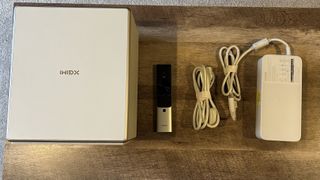
Every projector we test goes through a series of identical procedures to make sure we're getting a fair result for each device. We test projectors across their designs, features, and performance with a specific focus on cross-market comparison to ensure value for money. Crucially, though, we live, play, and stream through each projector for a minimum of two weeks, consuming all manner of content on the big-screen for a full real-world experience. We don't leave these devices in a lab after the working day is done, they come home and are integrated directly into our everyday lives.
That means the first thing we usually take note of is the design. Pulling the projector out the box, we're examining the device's size, shape, and weight to see what kind of influence that will have across portability, shelf space, and any mounting restrictions that might come up. From there we're looking to make sure the aesthetic can slot into a range of different decors and that the build quality (across materials, construction, and overall durability) is solid.
We test for a certain baseline of features in every gaming projector, across resolution, refresh rates, brightness, contrast, and color ranges. We also make sure the throw range is within reasonable limit for each setup, and that setup is eased through any auto-adjustments. Ports are assessed for their compatibility, ease of access, and breadth, as well as the appearance of a dedicated streaming stick. Beyond these basics, we're also looking for any extra speakers, lens shift, zoom, and wireless connection features.
We test the performance of each gaming projector across a series of defined games (Astro's Playroom / Astro Bot, Assassin's Creed: Mirage, Apex Legends, and The Last of Us Part 2) but also 4K and FHD HDR and SDR streaming content. We test brightness across light and dark scenes in natural daylight, medium ambient lighting, and complete darkness with a particular focus on clarity in those more shadowy moments. We're checking the vividity, warmth, tone, and contrast of colors. We also make special effort to test the latencies coming from consoles, as well as the fluidity of both high and low refresh rate models. Of course, we're always looking out for visual distortions like ghosting, blooming and rainbows.
At the end of this we score each projector across a series of six categories; versatility, ease of use, compatibility, build quality, picture quality, and brightness. You can find out more about how we test projectors as well as check in with the full 12DOVE Hardware Policy.
How to choose the right projector for gaming
Why you can trust 12DOVE

Before you even start considering different models, you'll want to know how big you want your display to be and how wide your room is. This will dictate the throw ratio of the projector you pick up. Throw ratio essentially describes how far away from a wall or screen a projector needs to be to show an image of a certain size. It's calculated by dividing the distance between your projector and the wall by the width of the image. A 120-inch display sits at 8.75ft wide, for example, and if your living room is 15ft wide you'll want to pick up a projector with a 1.7 throw ratio (15 / 8.75).
Projectors come in all shapes and sizes, and many aren't geared towards gaming at all. That means there are a few key specs to keep in mind when choosing the right model.
Input lag is the biggest differentiator between an everyday streaming device and a gaming-focused projector. Broadly speaking you need to aim for 50ms as a minimum acceptable level, while 40ms is better, and under 20ms is the holy grail. If you play a lot of highly competitive twitch-shooter games, you'll want to invest in a faster machine, but if you stick to single-player adventures or more methodical strategy games you can easily stretch to 40-50ms. How much you really need and must have the lowest possible lag will be down to personal preference: some people will barely notice the difference whereas others will curse anything less than the snappiest of times.
The next part is about setup. You'll want to make sure you're buying the right projector for your space. If you have a smaller gap between your display wall (or screen) and a shelf to set up on, then you'll want to opt for a short-throw projector. The best way to work out the throw ratio you need from your projector is to check the measurements of your room. A 120-inch screen size will need between 13 and 15 feet between the projector and your surface, but this will change between short-throw and long-throw devices.
A lot of high-end gaming projectors also tout additional refresh rate features. It's important to remember, though, that before the last couple of years the vast majority of displays (be they projected or simple TVs) ran at 60Hz. This is where you'll still find most projectors, though more specialist devices are moving up to 120Hz or a variable refresh rate since the PS5 and Xbox Series X hit the market. Things will look smoother on a higher refresh rate screen, but 60Hz is still pretty solid at this scale.
Brightness is going to be your next key consideration - you'll need to work out when you're most likely to play. A high-brightness projector can reach up to 5,000 lumens (for a price) these days, but the generally accepted minimum is 1,500 lumens. 3,000 - 4,000 lumens will comfortably display your picture in a room with casual ambient light, but the higher the brightness the better your darker scenes will be in this situation. If you only play at night or in an unlit room you can afford to drop your brightness a little, but if you want to play outside it's worth investing here.
Projector glossary
Buying a projector for the first time can be overwhelming - there's plenty of jargon in this world making working out the right projector for you all the more difficult. We're breaking down some of the more commonly used terms below.
- 3LCD - This is a brand name of a massively used projector technique, which splits white light into RGB strands through a series of mirrors to be directed through an LCD panel.
- Blooming - Blooming is a visual effect that reduces the clarity of your image due to excessive light in one spot bleeding into other areas of the picture.
- Color gamut - Color gamut is used to refer to the range of colors on offer from a particular projector. This is the number of independent colors a device can produce and is generally represented as a code.
- Contrast Ratio - The contrast ratio dictates how far apart your whites and blacks will be, displayed as white-to-black. A high contrast ratio (3000:1) will offer particularly bright high colors compared to darks.
- DCI-P3 - See 'Color Gamut' above. DCI-P3 is common color gamut level in entertainment devices. It specializes in green and red tones with a particularly wide band in these areas.
- DLP / DMD - DLP is a brand name for DMD technology, which is a projecting process using micro-mirrors. This process is longer lasting than LCD and offers a higher quality image.
- Ghosting - Ghosting is a visual effect of duplicate images appearing on the screen. It is usually caused by a syncing issue between the projector and its source.
- Input Lag - Input lag is used to refer to a drag in time between the image being generated by the projector and being displayed on the screen. It's measured in milliseconds, with a lower number being better for gaming.
- Keystone - Keystoning is used to refer to the process of correcting a projected image's shape. If the device is not properly inline with its screen, the resulting picture can lose its square shape. Keystone Correction fixes this.
- Lens Shift - Projectors with lens shift are far easier to place. The feature allows you to move the picture up, down, and side to side to get the right placement.
- Lumen - A lumen is a measurement of brightness in projectors, describing the power output.
- Native Resolution - Whether it upscales or not, every projector has a native resolution. This is the highest resolution available from a hardware standpoint; usually either 1080p or 720p. Many 4K projectors run at a 1080p native resolution and then use software to improve the image quality up to UHD.
- Throw Distance - This is the optimal distance between your projector and the wall you're displaying on. It determines brightness and image size when connected correctly.
FAQ
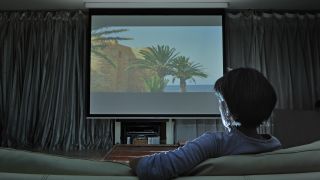
What is the best projector for gaming?
The best projector for gaming right now is the BenQ X3100i However, if you don't need the full force of a 4K projector, we'd recommend checking out the BenQ X1300i for a 1080p experience.
Are projectors too slow for gaming?
This is a genuine concern, and probably the most persistent one still, as speed has never traditionally been a strong point. Literally having to throw a picture out from the unit means that latency has always been a concern. The good news is that modern gaming projectors have never been better in that respect and you can safely get a machine that's below the 50ms mark - the minimum you should aim for. The bad news is that the lowest ms times are reserved for those most expensive projectors.
Is a projector good for PC gaming?
In short, yes! It can work, and it can be a wholesome, massive experience. Hooking up a super-powerful rig to one of the best gaming projectors can be quite the experience, and the power of the PC will get great results out of a projector.
Given the living room size of the screen, however, we often think that console players might be a more natural fit (perhaps from a 'traditional' perspective more than anything), but if you game on PC in the living room anyway then a projector could be the display upgrade you've been looking for!
If you prefer your screens TV-shaped then check out our guides to the best TV for PS5 and Xbox Series X, best 120Hz 4K TV, best QLED TV, and best OLED TV.
Sign up to the 12DOVE Newsletter
Weekly digests, tales from the communities you love, and more

Managing Editor of Hardware at 12DOVE, I originally landed in hardware at our sister site TechRadar before moving over to GamesRadar. In between, I've written for Tom’s Guide, Wireframe, The Indie Game Website and That Video Game Blog, covering everything from the PS5 launch to the Apple Pencil. Now, i'm focused on Nintendo Switch, gaming laptops (and the keyboards, headsets and mice that come with them), PS5, and trying to find the perfect projector.
- Will DonovanFreelance Writer
